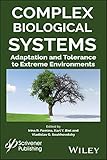Complex biological systems [electronic resource] : adaptation and tolerance to extreme environments / edited by Irina R. Fomina, Karl Y. Biel, and Vladislav G. Soukhovolsky.
Material type: TextPublication details: Beverly, MA : John Wiley & Sons, Inc.,, 2018.Description: 1 online resource : color illustrationsISBN:
TextPublication details: Beverly, MA : John Wiley & Sons, Inc.,, 2018.Description: 1 online resource : color illustrationsISBN: - 9781119510376
- 1119510376
- 9781119510390
- 1119510392
- 570.113 23
- R853.D37
Description based upon print version of record.
Front Cover; Title Page; Copyright Page; Contents; Preface; Abstract; Contributing Authors; MODELING AND APPROACHES; 1 Critical Impacts on Complex Biological and Ecological Systems: Basic Principles of Modeling; 1.1 Complex Ecological Systems: The Principle of Decomposition, Taking into Account the Characteristic Times of Components; 1.2 Analysis of Critical Impacts on Complex Systems and Extreme Principles of Modeling; 1.2.1 Meta-Models of Phase Transitions for Describing Critical Events in Complex Systems; 1.2.2 A Model of Outbreak as Second-Order Phase Transition
1.2.3 The Effect of Modifying Factors on the Development of an Outbreak1.2.4 The Impact of Chemical Compounds on Biological Objects; References; 2 Criticality Concept and Some Principles for Sustainability in Closed Biological Systems and Biospheres; 2.1 Introduction; 2.2 History of Manmade Closed Ecosystems; 2.3 Classification of Closed Biological Systems; 2.3.1 Terminology; 2.3.2 Micro Systems; 2.3.3 Macro Systems; 2.3.4 The Term Biosphere; 2.3.5 Noosphere; 2.4 The Concept of Criticality; 2.4.1 The Volume-Criticality Principle; 2.5 Microbiospheres: Descriptions and Discussion
2.5.1 The Ecosphere, a Synthetic Microbiosphere2.6 Bioboxes; 2.7 Experimental vs. Mathematical Models; 2.7.1 Retrograde Phylogenetic Extinction; 2.8 Humanospheres: Examples and Discussion; 2.8.1 Biotubes; 2.8.2 Shepelev, BIOS 1, 2, and 3; 2.8.3 Biosphere 2 Laboratory; 2.8.4 Closed System Missions; 2.8.5 Open System Missions; 2.8.6 The End of Biosphere 2 Laboratory or a New Era for Biosphere 2 Laboratory?; 2.9 The Earth (Biosphere 1) Description and Discussion; 2.9.1 Earth, a Sample Size of One; 2.9.2 Biosphere 1 Properties; 2.10 Oxygen Flux in Closed Systems
2.11 The Future of Closed System Work: Concepts and Strategies2.11.1 Education, Research and Consortium Concepts; 2.11.2 Ecosystems for Space; 2.11.3 Closed System Challenges; 2.12 General Conclusions; Abbreviations; Literature Cited and Used; Appendix I. A Description of Biosphere 2 Laboratory; 3 Accelerated Method for Measuring and Predicting Plants' Stress Tolerance; 3.1 Introduction; 3.2 Background; 3.2.1 Interaction between Anabolism and Catabolism; 3.2.2 Cooperation between Photosynthesis and Respiration under Stress; 3.3 How Is Stress Tolerance Measured?
3.3.1 Testing Possible Artifacts of the Stress Test3.3.2 Effect of Temperature and Chemical Additions on the Oxygen Evolution Stress Assay; 3.4 Practical Applications; 3.4.1 Whole Leaf Physiological Responses; 3.4.2 Effect of Dark and Sodium Nitrate on the Photosynthetic Stress Resistance Index and Photosynthesis in Leaf Slices under Anoxic Conditions; 3.4.3 Post-Illumination Respiration; 3.5 Discussion; 3.6 Perspectives for Application of Method; Acknowledgments; Abbreviations; References; Appendix I. Additional Materials and Methods
Appendix II. Preliminary Analysis of the Utility of a Novel Stress Resistance Assay on Three Garst Lines of Zea mays, a C4 Plant
There are no comments on this title.
